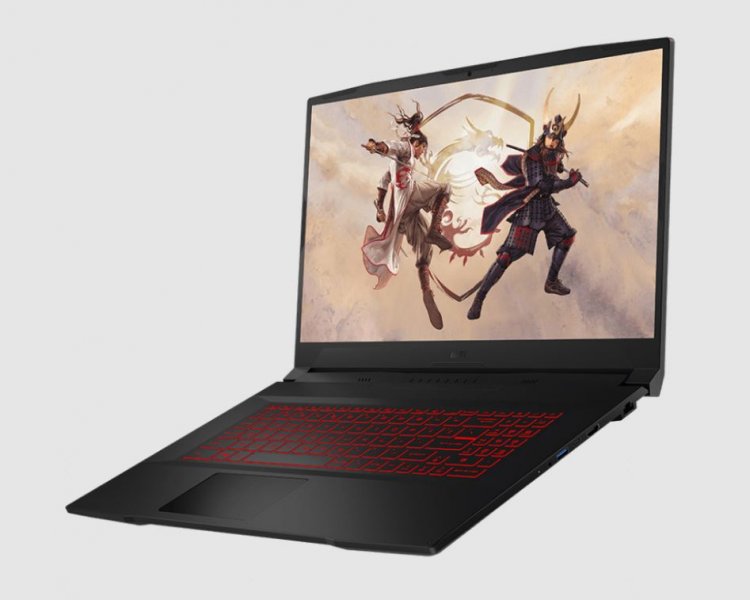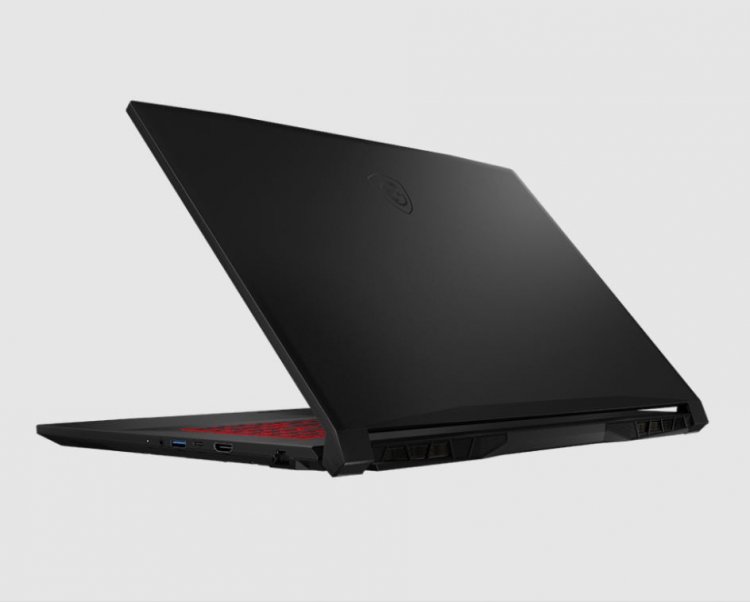MSI Katana GF76 review: Good gaming performance at an affordable price
The MSI Katana GF76 Laptop is an excellent choice for budget-conscious gamers.

MSI Katana GF76 review
Pros
- Decent CPU performance
- Interesting design with plenty of flairs
- Comfortable keyboard and trackpad
Cons
- Lackluster GPU performance
- The display lacks brightness
- Audio produces less-than-stellar bass
The MSI Katana GF76's 12th-generation Intel Core i7 CPU provides adequate CPU performance for a cheap 17-inch gaming laptop. Furthermore, its Japan-inspired chassis emanates a lot of styles. The laptop's 3050 Ti GPU performance, on the other hand, may disappoint certain gamers. On the one hand, it allows you to play games with dramatic ray-tracing graphics at a modest price, but on the other hand, it's quite underpowered, especially when performance sliders in MSI Center are pushed all the way to the right.
In that scenario, suggesting this laptop is a case of horses for courses. The MSI Katana GF76 is a good choice if you don't mind mediocre performance in some recent games. If nothing less than super-fast framerates are required, you might want to select one of the step-up versions with RTX 3060 or RTX 3070 GPUs.
MSI Katana GF76 Specifications
The MSI website lists seven different configurations of the GF76 Katana. All have Intel Core i7-12700H CPUs from the 12th generation, but differing RTX 30 series GPUs and storage capacity. At the time of writing, only four configurations were available: two with RTX 3050 Ti starting at $1,250 (now $1,099) and two with RTX 3060 starting at $1,399. A configuration with an RTX 3070 and another with an RTX 3070 Ti, as well as a third with an RTX 3060, have been marked as 'coming soon.' These apartments' prices have yet to be announced. Our review unit's specifications are as follows:
- Display: 17.3-inch FHD (1920 x 1080), non-touch, IPS-Level panel, 144Hz refresh rate, 45 percent NTSC
- CPU: Core i7-12700H
- RAM: 16GB DDR4/3200MHz
- GPU: Nvidia GeForce RTX 3050Ti
- Networking: Wi-Fi 6 (802.11ax 2×2), Bluetooth 5.2
- Dimensions: 15.67 x 10.75 x 0.99 inches
- Weight: 5.73 lbs (2.25kg); the power brick weighs 0.9 lbs (400g)
- Storage: 512GB PCle 4 SSD
- Ports: 1 x USB Type-C 3.2 Gen1, 2 x USB Type-A 3.2 Gen1, USB Type-A 2.0, HDMI 2.0 (4K @ 60Hz), 3.5mm Combo jack, RJ45 Gigabit Ethernet
- Operating system: Windows 11 Home
- Color: Black
- Battery capacity: 53Whr
MSI Katana GF76 Design and build
Those who have seen the 2021 GF76 Katana will observe that the design hasn't changed significantly in the 2022 model. The MSI Katana GF76 still has a samurai feel to it, like a weapon of battle or a well-made suit of armor from medieval Japan. It boasts an all-black casing with red lighted keys and high curving corners. This design is said to be the creation of Japanese illustrator Tsuyoshi Nagano, who is most known for his work as the original cover artist for the Romance of the Three Kingdoms games.

Aside from the design pedigree, the samurai katana theme makes it a wonderful looker and one I was glad to play on at any opportunity. The most noticeable characteristic of the laptop is a strong spine with curved edges positioned at the base of the display, which, from the back, resembles the blade of a katana. This feature makes it very easy to transport. The front of the base also contains convex curves that mimic katanas. These curves match the matching curves on the top of the lid, allowing it to fit snugly down like a clamshell. Because of its small size, the laptop is easy to clean.
When it comes to build quality, the 2022 GF76 Katana feels largely plastic, but not the brittle plastic found in some other budget gaming laptops. Make no mistake, this is a tough laptop with a sturdy feel around the keyboard and base, which are likely to receive the most abuse in fast-paced games. It's rather enormous, measuring 15.67 x 10.75 x 0.99 inches, so you'll need plenty of room to set it down.
The metal hinges keep the display securely in place in whichever position you choose. However, because the top is narrow, there will be some flex if you apply pressure. It also wobbles somewhat when bumped, although it doesn't bounce in a light breeze, making the GF76 appropriate for outdoor gaming.
Because of the use of plastic in the chassis, the MSI Katana GF76 is on the light side for a 17-inch gaming laptop. It only weighs 5.73 lbs. It weighs less than the Asus Rog Zephyrus (6.06 lbs) and Gigabyte Aorus 17G (5.95 lbs), but more than the Dell XPS 9710. (5.34 lbs). This makes it more portable than others. However, it is hefty enough that you will not want to take it everywhere you go.
When you look at the 16:9 display, you'll notice that the left and right bezels are extremely tiny. The top bezel mimics the design of the aforementioned front lid while remaining unobtrusive to your viewing experience.
Despite its unusual curved edges, the style of the MSI Katana GF76 is subtle. There are only two logos, both of which are rather small — a beautiful black-on-black MSI Dragon appears as an engraving on the top front of the lid. The grey MSI writing on the lower bezel beneath the display is the other. It replaces the 2021 edition's black-on-black variant, which appeared to be an erased word.
While most laptops have practical undersides, MSI has made a fashion statement with this one. Flipping the unit over shows a slew of honeycomb-shaped air vents that, based on the lack of heat we experienced while playing, are as functional as they are fashionable.
MSI Katana GF76 Keyboard and touchpad
Despite taking some getting used to, the keyboard and trackpad left a great impact on me. The keys didn't feel overly mushy or slow for typing on, with adequate key travel to respond promptly when I pressed them. The trackpad also performed admirably. It immediately recognised clicks and appeared to be fairly responsive to my finger movements.
MSI has maintained the same keyboard and trackpad positioning as last year. One apparent difference is that several keys that previously had only symbols now have text on them. This improves their appearance and should make them easier to find.
Some may decry the use of a single red hue for the backlighting, but I found it gave the keyboard a ferocious aspect that looked impressive even when the lights were turned off. You could even argue it revs you up a little, quietly encouraging you to keep your cool in the game.

MSI has guaranteed that you may switch between three brightness levels or turn off the backlighting entirely if you want to save electricity. This disables the illumination, but for better or worse, the keys remain rather red with the backlighting turned off.
The keyboard typeface, which is somewhat different from what we're used to, can be a source of frustration when typing. Even though I'm a confident touch typist, it threw me off for a bit. It perplexes you for a single second when you look down at your hands and think... Is that a G or an O I just hit? It can be a little annoying at times because certain keys are too similar.
MSI Katana GF76 Display and audio
The 17-inch FHD display of the MSI Katana GF76 gives you plenty of visual real estate to immerse yourself in your games. It also offers a crucial feature that I look for in a gaming laptop: a good refresh rate. It is 144Hz in this situation.
The speedy display kept games and media looking fluid for the most part, with little discernible micro stuttering. When the pixel rate failed to keep up with fast-moving visuals, there was only a faint sense of ghosting visible.
When it comes to colour and contrast, it's totally adequate for a low-cost laptop. You won't get the kind of colour depth you'd get with a higher-end panel, and some photos will appear washed out, especially if you're used to 4K. However, the display only has a 45 percent NTSC colour range. This is adequate coverage for a laptop priced under $1300. You'll barely notice if you're not performing photography or design work.
The most significant disadvantage is the display's brightness. We measured 270 nits of peak brightness, which isn't excellent even for a low-cost unit these days. It's adequate for indoor viewing, but you'll probably want to avoid playing outside in direct sunlight.
The two 2 watt speakers for the GF76's audio are positioned beneath the front left and right of the laptop's base. Despite their location on the bottom, they generate sound with remarkably strong mid and high-range tonal integrity. However, the bass range is underwhelming, especially for a laptop of this size.
MSI Katana GF76 Connectivity
The MSI Katana GF76 comes with a good selection of ports, including USB Type-A and Type-C connectors. With an HDMI 2.0 connector, you can connect an additional display or TV and stream 4K images at up to 60 frames per second. It also includes an ethernet port for gamers that require the highest network connectivity.
Unfortunately, the MSI GF76 Katana lacks a Thunderbolt 4 interface, which is a great feature that allows you to transport large game files at data rates of up to 40Gbps. Despite this, the laptop supports the latest Bluetooth 5.2 and Wi-Fi 6 technologies for speedy unplugged connectivity.
MSI Katana GF76 Performance
Katana's performance on the GF76 is truly a two-edged sword (pardon the pun). It has a lot of CPU power thanks to its 12th-generation Intel Core i7-12700H CPU, which was too fast for the older chipsets in our test group. However, its RTX 3050 Ti GPU performed poorly at times, particularly in newer 3D games. It contrasted sharply with the laptop's CPU performance.
We compared the $1,250 GF76 Katana against a collection of gaming laptops from recent PCWorld reviews. The sizes and hardware combinations of these laptops vary, but the majority have older CPUs and all have more powerful RTX 30 Series GPUs. Other 17-inch gaming laptops on the list included the Gigabyte Aorus 17G, the Dell XPS 17, and the Asus ROG Zephyrus S17. The HP Victus 16 with a Core i7-11800H CPU was also featured in the lineup. Despite its smaller size, this last laptop's beginning setup falls into the same budget gaming bracket as our review unit.
First, we performed the Cinebench R20 benchmarks from Maxon. The single-threaded benchmark measures real-world processor speed, while the multi-threaded score reflects how quickly the CPU executes multi-processing activities such as rendering and encoding.
As shown on the graph for our single-threaded test below, the GF76 Katana rated highest among our competitor laptops, outperforming even the pricey Asus ROG Zephyrus S17 with its sporty 11th-generation Core I9 processor.
Similarly, outstanding performance was obtained when all 14 Cores of our GF76's i7-12700H chipset were tested, demonstrating that this laptop is capable of doing a variety of CPU-intensive applications including 3D gaming and transcoding.
The free HandBrake 0.9.9 utility software is used in our next test to convert a 30GB 1080p MKV file to MP4 using the Android Tablet Preset. The MSI Katana GF76 showed to be a capable performer once more, completing the assignment faster than two of its 17-inch competitors. This result demonstrates that the GF76 has the legs to keep functioning under significant CPU load before overheating and having to reduce performance.
Both CPU test results confirmed Intel's new 12th-generation CPU chipsets' superiority over previous Intel and AMD chipsets. These include both Performance and Efficiency Cores, which Intel Thread Director divides jobs across to maximize performance. The Core i7-12700H in our GF76 has 6 Performance Cores and 8 Efficiency Cores, offering it a performance advantage over certain older Intel CPUs with only Performance Cores.
MSI Katana GF76 Gaming performance
In terms of gaming performance, the MSI Katana GF76 routinely outperformed in older 3D games, while its RTX 3050 Ti GPU set to 60W Total Graphics Power (TGP) lagged in newer AAA titles that largely rely on the laptop's GPU. This circumstance was reflected in our gaming benchmark results, which are shown below.
We ran the 3DMark Time Spy 1.2 benchmark to gain a basic impression of 3D gaming performance. Our evaluation unit's score is behind rival laptops with more powerful GPUs – notably the MSI GE76 Raider with 12th-gen i9 CPU and RTX 3080 Ti GPU, which isn't a budget laptop but we included for comparison (in green).
In our Rise of the Tomb Raider benchmark (approximately 2015), the MSI Katana GF76 performed admirably, outperforming even the Razer Blade 14 with Ryzen 9 5900HX CPU and GeForce RTX 3080 set to 100W TGP.
When we tested the newer and more GPU-dependent Metro Exodus benchmark, the story was dramatically different. Our review unit arrived after the rest of the field.
In both of these benchmarks, switching to Performance Mode in the MSI Center and using the CoolerBoost fan setting increased Katana's frame rate. It soared to a respectable 96 during the Rise of the Tomb Raider benchmark. The Metro Exodus benchmark produced a result of 24 frames per second. However, returning to the Metro Exodus table, this score would not have impacted the MSI GF76 Katana's place among our comparisons.
So, what does the final outcome imply? This implies that we must have some perspective on the hardware capabilities of this laptop's GPU. The MSI Katana GF76 is a low-cost gaming laptop, and the RTX 3050 Ti is ranked second from the bottom of the RTX 30 Series line-up, with less power than the GPUs in our test group. This makes a significant difference in GPU-heavy games.
The RTX 3080 is equipped with 6144 Nvidia CUDA cores, 192 Tensor Cores, and 48 Ray Tracing Cores. There are just 2560 CUDA Cores, 80 Tensor Cores, and 20 Ray Tracing Cores in the RTX 3050 TI. If you need more power and have a higher budget, you may always go with an MSI GF76 with an RTX 3060 or 3070 GPU.
Our review unit, on the other hand, remains a viable choice. According to Nvidia, the GeForce RTX 3050 Ti is 40% quicker than the older GeForce GTX 1650 Ti and 20% faster than the RTX 3050, which is nothing to sneeze at.
MSI Katana GF76 Battery life
The MSI Katana GF76 comes with a three-cell 53Whr battery, which appears to be inadequate for a laptop of this size. However, our lightweight battery test, it lasted more than 5 hours. By playing a 4K video on loop, we were able to reduce the battery from 100 percent to standby. This result indicates that you may expect roughly 3 hours of battery life for an unplugged gaming session, which is comparable to other similar laptops.
Conclusion
The MSI Katana GF76 is a low-cost 17-inch gaming laptop with a good CPU. The RTX 3050 Ti GPU is a touch underpowered for the most recent AAA games, but you can still enjoy RTX visuals for a fraction of the price of a more expensive laptop. Although we had hoped for better gaming performance, this laptop is still worth considering, especially if you're on a tight budget.

 Mike2051
Mike2051 








